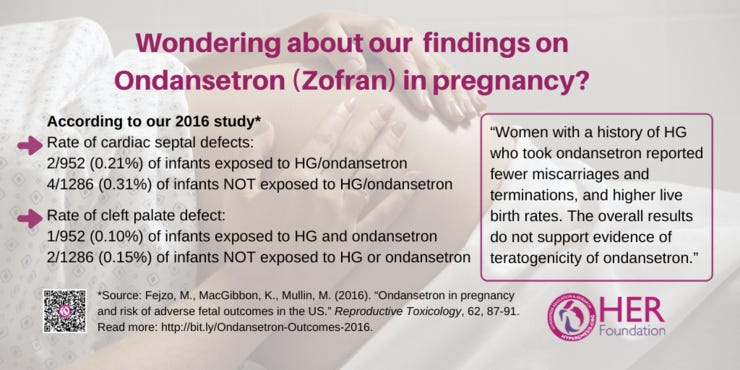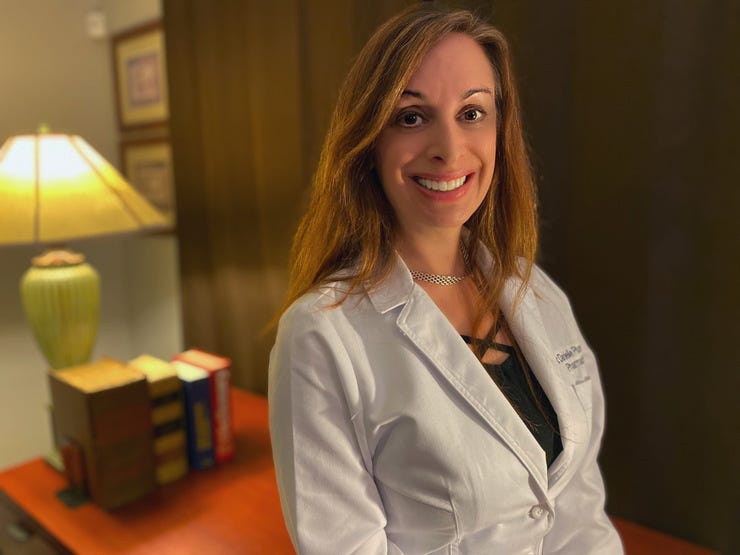FarmaKology Newsletter - Issue #46
Strategies for Pharmacists to Support Women with Hyperemesis Gravidarum
International Hyperemesis Gravidarum (HG) Awareness Day made a statement in much of the world on May 15th, yet many pharmacists are still unaware the condition exists. “HG is hyperemesis gravidarum: a potentially life-threatening pregnancy disease that may cause malnutrition, dehydration, and debility due to severe nausea and vomiting, and may cause long- term health issues for mom and baby.” Now is the time for pharmacists to step up and use their knowledge and accessibility to support (HG) sufferers!
While 80-90% of pregnant women experience some level of nausea and vomiting in pregnancy (NVP), often called morning sickness, statistics show that up to 3% of women have the extreme condition of HG. This equates to around 120,000 women in the US alone in 2019, which categorizes it as a rare, or orphan, disease. Due to the fact that many women are told “it’s just morning sickness” from their doctors, or when hospitalized for rehydration the visit is not coded as HG, the number may be far higher, and therefore not a rare disease.
HG catches most women by surprise as it is contrary to the anticipated glowing pregnancy. Before understanding how pharmacists can help women suffering from HG, take a look at these powerful statistics:
Continue reading Here
How can a pharmacist help?
Regardless of your pharmacy setting, there are many ways to help. To begin, understand the treatment options, both inpatient and outpatient, as these were probably not discussed in pharmacy school or have most likely changed since you graduated. Share the HER Foundation Treatment Algorithm with all obstetricians, midwives, ER doctors, hospitalists and anyone else you know who works with pregnant women. Additionally, brochures, posters and other literature for pharmacies and medical practices are available from their site. These are currently being translated into multiple languages. If you speak additional languages, consider volunteering to translate these materials as the goal is to increase education and awareness around the world.
Retail pharmacists:
Retail pharmacies are often the first place a pregnant woman will go to seek help when she cannot reach her doctor. Retail pharmacists can help far beyond the dispensing and counseling of medications by using the depth of knowledge regarding active ingredients, variation of brands and processing insurance claims to help these women gain access to medication. Here are some examples:
If a patient comes into the pharmacy with a prescription for Diclegis or Bonjesta, and they cannot afford it or their insurance does not cover it, encourage them to reach out directly to the manufacturer for rebate coupons in addition to showing them the closest OTC equivalents to the two ingredients.
Explain that they can ask their insurance company if there is an equivalent or a specific amount of medication that is covered on their formulary. Insurances often just reject the claim instead of explaining what is covered. Sometimes, they will cover the medication if the doctor completes a “prior authorization.”
Depending on how far along they are in the pregnancy, explain that options to help with stomach acid, reflux and constipation are available. Additionally, first time pregnant women are often hesitant to ask about constipation, so take the lead and mention it, as discussing this topic might allow for a huge improvement in her quality of life.
Continue reading Here
Hospital Pharmacists
Many emergency physicians only know what they learned about HG in medical school. Hospital pharmacists are in a position to educate hospital staff on updated treatment guidelines. With constant medication recalls and formulary changes, ensure the hospital practitioners stay up to date on which medication to choose and why. If you see an order for a woman in your emergency room for “dehydration due to pregnancy”, ensure she is not only getting fluids but also B vitamins and electrolytes. Adding thiamin to the rehydration solution offers an exponential amount of relief which sometimes lasts after discharge. I am currently working with a team to create a banana bag specific for an HG patient, as these women are not being treated for alcohol use disorders.
Continue reading Here
Infusion Pharmacies
Pharmacists that work for infusion pharmacies have a unique opportunity in the care of HG patients. For example, if you are dispensing ondansetron for home health, please communicate with the home health nurse and the patient on how to use the pump and titrate the medication.
Additionally, please reach out to your local obstetrician offices and hospitals so they know your services are available. Many women go to the hospital for rehydration, when it would be safer and more convenient to have fluids infused at home.
Understanding the ondansetron (Zofran) controversy
Although Ondansetron (Zofran) was originally FDA approved for post-operative nausea and vomiting and nausea and vomiting associated with chemotherapy and radiation therapy, it has been used off label around the world to treat nausea and vomiting in pregnant women for decades. It was never first line in any protocol, and offers tremendous relief for many women who failed first line medications. Additionally, many women prefer it because it does not cause drowsiness, allowing the women to have an increased quality of life including continuing to work and take care of other children. The safety of ondansetron when taken during pregnancy is now being questioned due to conflicting study results.
Continue reading Here
Pharmacogenetic testing
While the science of pharmacogenetics is still emerging, there are immediate reasons that testing a patient with HG is clinically important:
The MTHFR gene mutation will determine if folic acid can be metabolized. If it cannot, recommend an l-methyl folate supplement, instead of folic acid.
The MMADHC metabolizes B12. With this mutation, recommend methylcobalamin instead of cyanocobalamin.
Histamine-2 Receptor Antagonists (H2RAs) and Proton Pump Inhibitors (PPIs) are all CYP450 enzymes, predominantly C219, but also 1A2 and 2D6. Dose the medication based on the enzyme variation of the patient.
Steroids, although far down the treatment algorithm, can be a gamechanger to an HG patient. Methylprednisolone (on the HER algorithm), prednisolone and prednisone are ABCB1 genes. Again, dose based on the variant.
Ondansetron (Zofran) are also ABCB1. It turns out that the variation I have can actually INCREASE my likelihood of nausea and vomiting!
CBD and Marijuana Products
Pharmacists are now getting many questions on whether it is safe to use CBD and/or marijuana products to treat HG. Depending where you live, these products may be accessible, and some products are even being endorsed by celebrities for this reason, but as of today, there are limited clinical studies showing safety or efficacy during pregnancy.
I have seen a range from products being prescribed by doctors and dispensed in pharmacies where marijuana is legal, to hearing stories where women are taking it without their doctor’s advice or permission resulting in the threat of social services taking away their baby. One very small study in Israel showed potential in offering relief to HG patients, so I do hope that more research is done quickly. If you’re a pharmacist interested in cannabis, consider joining the International Society of Cannabis Pharmacists.
What the future holds
It is time for awareness, research and treatment options to be a priority! If you have ways to spread awareness or offer support to patients, providers, health systems or other sources, please do so immediately. If you know a pharmacy student looking for a research project, suggest hyperemesis gravidarum. With so many unanswered questions, and due to the difficulty in testing medications in pregnancy, consider researching causes and prevention methods. Because many HG women stop after one pregnancy for fear of having a second HG pregnancy, reach out to one of the following organizations for ways to prepare for a subsequent pregnancy.
Additionally, please reach out to one of the following organizations to be involved in future research projects or support one of the many hyperemesis gravidarum associations around the world.
USA with support groups in New Zealand, Indonesia, Kenya, the Netherlands and Canada: www.hyperemesis.org
Ireland: https://www.hyperemesis.ie/
As a final note, encourage women to have the confidence to know that if they are not being taken seriously by their doctors, then to find one who will treat them with respect and address all of their concerns. Understand that a woman should never be told that there is nothing more that can be done, including medication and other treatment options.
Finally, please spread the word that not only there is help available to current sufferers through medical practitioners, but that survivors are ready and waiting to offer support through Facebook Groups and social media platforms. No one should suffer alone!
HER Foundation
About the Author
Dr. Danielle R. Plummer is a three-time Hyperemesis Gravidarum survivor. She is a hospital pharmacist practicing in Las Vegas, NV, a board member of the HER Foundation and runs an HG consulting service: www.hgpharmacist.com





